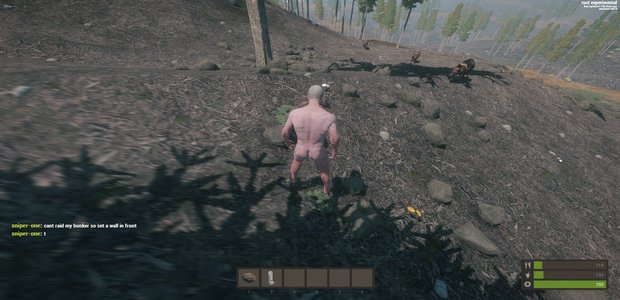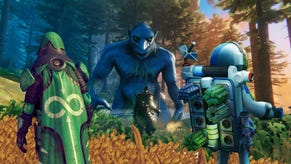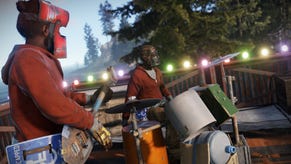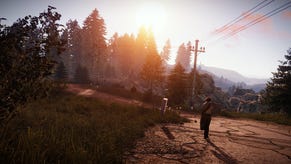Impressions: Rust's New Version
Rust In Pieces
As of last month, developers Facepunch (headed by Garry Newman of Garry’s Mod fame) declared that what was previously known as ‘Experimental Mode’ is now the definitive version of Rust. It now launches by default on Steam, with an option to play on the old ‘Legacy’ servers instead if you’re not ready for change. Unfortunately, I don’t think the game’s quite ready itself.
Spawning in Rust used to entail waking up in the wilderness hungry, naked and alone with only a rock and torch to make your way in the world. In the latest build you spawn alone, naked, hungry and thirsty, with just a rock. My first life started on a border between a forest and the recently added arctic biome. With the most interesting thing nearby being a deer, I did the logical thing and caved its head in. I went on to harvest a ludicrous amount of cloth and animal bones as well as, inexplicably, some wolf meat and a wolf skull - before ironically being eaten by an actual wolf shortly after. Rust is a mean place, even without its human denizens.
Now running in version 5 of the Unity engine, that mean place is certainly prettier. Like other survival games of its ilk, there’s a large amount of downtime in Rust, meaning atmosphere counts for a lot. Wandering the landscape, searching for resources and hoping for chance encounters with strangers forms the bulk of the game. This wasn't previously the case: one of the largest changes made across engines is to the map itself. Instead of a relatively small area focused around structures and a single ring-road placed by the devs, each server now hosts its own massive, procedurally generated world. It has the potential to create moments of discovery that fixed environments can’t manage, but currently the generated worlds looks too repetitive to properly deliver on that front. It also makes meeting up with friends a nightmare.
The increased world size comes with an increase in max player count, with the official servers all hosting up to 500 players. However, on average there’ll only be about 50 other Rusters running around at the same time, resulting in the world feeling kinda lonely. In my first few hours with the game, I only encountered a couple of other people - and they were all sleeping (in what remains one of Rusts’ finer features, logged out players remain in the world unconscious). In lieu of anything more interesting to do I took their stuff, filled their pockets with wolf skulls and moved on.
In contrast, after ten minutes of playing on Legacy mode a kid had invited me to move into the cave next door to him and his friend. After another ten minutes I’d fended off a naked attacker as he shouted gibberish down his mic, and would in quick succession go on a hunting trip in which I accidentally shot an arrow through my new acquaintance's chest, and be forced at gunpoint to tea-bag a sleeping person we’d happened across in the wilderness. Ten minutes after that I was dead, shot in the back of the head by a stranger as my new friends and I sheltered around a campfire.
The change of pace might be deliberate, but I’m not sure it’s welcome. Legacy feels relentless, but new Rust can feel placid. This isn’t to say that it doesn't also introduce numerous improvements. Perhaps most notably, better anti-cheat software has solved the hacking problem that plagued the old game. The second person I met in Legacy mode demonstrated this by enthusiastically flying 100 feet into the air. Depressingly, when I asked him why he cheated he said it was to protect himself from other hackers.
The devs are also expanding the survival elements of the game, adding new status effects such as ‘wet’. I owed one of my early deaths to hypothermia after I attempted to swim across an icy river. There’s still a long way to go: the only way to satisfy the new ‘thirst’ metre is just to eat as normal. As befitting an early access title, the systems are also in a constant state of flux, with some fun mechanics being patched out for the sake of balance. The ability to open an alive players inventory was recently removed, for example, resulting in me having to kill every sleeping player I see and ruining my ability to replace all their stuff with wolf skulls.
Crafting remains largely the same, though there are significant changes in the pipeline. The blueprint system is still in effect, where plans for items not in the basic set have to be found and learnt, but can then be built by subsequent characters after you die - providing you stick to the same server. It lends a sense of achievement that persists across otherwise doomed playthroughs. However, there’s worrying talk of introducing blueprints through random Steam drops that can then be traded. Despite the developer’s reassurances, it’s hard not to imagine the system rewarding larger wallets over invested playtime. The other side of crafting, base building, has been streamlined. It’s easier to quickly gather the resources needed to make a basic shelter, and to put it together. It can still be a daunting task though, as I found when I got bludgeoned to death from behind while my guard was down. Attempting to steal a house went little better.
I’d spawned next to a basic hut, warmth and light emanating from the inside thanks to a lit bonfire. Someone was home! Without any equipment to break my way inside, I figured my best bet was to wait outside and ambush the guy as he came out. I crept into some nearby bushes and settled in - only to realise someone else had had the same idea. Fortunately he’d logged off, leaving me free to take out his sleeping body and instantly acquire a good set of gear. After a bit more skulking, I realised that now I could probably just break in.
It took me two minutes to get through the roof. I dropped down, taking out my freshly pilfered spear in expectation of a fight - but the guy had vanished. His stuff was scattered around as if he’d purposefully dropped it before somehow disappearing. It didn’t matter to me: within five minutes I’d scored two inventories worth of loot and an entire house. All I needed to do was replace the code-locked door with my own. After an age of chopping, I’d destroyed the previous tenant’s handiwork. The door’s code-lock, however, remained hovering in place: bugged out. Without any way to build over it or destroy it, my move-in was thwarted.
Rust clearly has potential. Swapping to Unity seems to have been the right move for the devs, as in the long-term procedural worlds and larger server counts should bear fruit - but it’s too unstable in its current state to be enjoyed properly. As well as that glitch with the lock, I found animals frequently wouldn’t attack me, my framerate would slow to a crawl, and occasionally servers would simply disconnect me. Performance issues at least have been acknowledged on the regularly updated dev blog, so there's reason to think the problems will be addressed and that, with more time, Rust may yet achieve the compelling blend of stranger management and freeform construction it’s aiming for.














